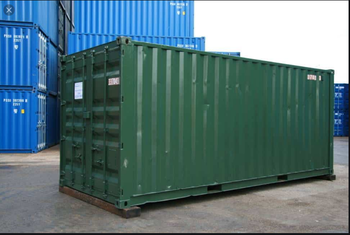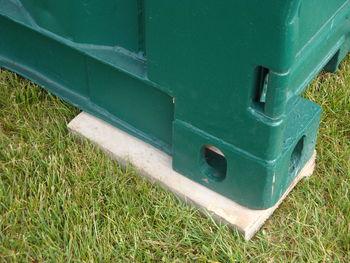************Our office closes for Easter at 5.30pm on Thurs 17th April, and will reopen on Tues 22nd April at 8.30am************
The Bottom Line - What To Put Under Your Shipping Container
Tuesday 19 May 2020
Updated: Tuesday 1 October 2024
Filed in: General
Where you choose to place your shipping container is very important to prevent future problems with using the doors. In particular original shipping container doors (ISO doors) can be a bit of a heave-ho to open and close, and if the container isn't sited on hard-standing, level ground this can make things worse. The simple solution is to plan and prepare for delivery in advance.
What happens to containers on uneven ground
 Known in the trade as "racking out", if just one corner of the shipping container isn't level the container will twist slightly which causes the doors to go out of alignment, making them difficult to use. This is made worse if the load inside the container is unevenly distributed. Soft ground, such as grass will cause the corners of the container to sink in, which also causes racking out.
Known in the trade as "racking out", if just one corner of the shipping container isn't level the container will twist slightly which causes the doors to go out of alignment, making them difficult to use. This is made worse if the load inside the container is unevenly distributed. Soft ground, such as grass will cause the corners of the container to sink in, which also causes racking out.Standing your container on a hard, level surface prevents these problems, but of course, we understand that this is not always an option. Many of our customers will want to place their shipping containers in fields and gardens, on grassy terrain. If this is the case then it's important to make sure the bottom of the container is raised slightly from the ground. Not only does this prevent sinking, but will protect the underside of the container from rapid deterioration caused by permanently sitting in wet, muddy puddles with no airflow to dry it out . This is possible with a few options and careful preparation pre-delivery.
How to prevent a container from racking out
Whatever you use to put under the container it's important to ensure the weight is evenly distributed across the ground in all four corners. We recommend either concrete or wooden blocks for this.Ground Preparation
Adequate preparation of the ground under the container ensures a solid foundation and maximizes the effectiveness of the blocks. Before placing any blocks under a shipping container, proper ground preparation is essential. The ground must be levelled thoroughly - start by clearing any obstructions or debris as these can affect the stability of the container. Then compact the ground surface to prevent shifting or sinking of the blocks over time.Concrete slabs
 A level base can be created by laying a concrete foundation. However, a simpler option is to place concrete slabs at each corner. As long as the slabs are larger then the corner casting above them, they will be able to take the weight. Concrete blocks not only have excellent strength and weight-bearing capacity, they are also easy to source and are very resistant to exposure to the elements, so they won't need replacing in the lifetime of the shipping container.
A level base can be created by laying a concrete foundation. However, a simpler option is to place concrete slabs at each corner. As long as the slabs are larger then the corner casting above them, they will be able to take the weight. Concrete blocks not only have excellent strength and weight-bearing capacity, they are also easy to source and are very resistant to exposure to the elements, so they won't need replacing in the lifetime of the shipping container.The downside of using concrete is their weight, which makes them heavy to transport and tricky to handle. Small adjustments which may be needed during, or after placement are going to take a lot more effort than lighter materials.
Railway sleepers
 Sleepers can be purchased from Containers Direct at just £180 plus VAT for a pair. These should be placed one under each end of the container. They are much lighter than concrete, easier to handle and adjust, which makes them more suited to DIY installations. They can also be cut to fit the specific dimensions of the shipping container, leaving no over-hang, which can be a trip hazard.
Sleepers can be purchased from Containers Direct at just £180 plus VAT for a pair. These should be placed one under each end of the container. They are much lighter than concrete, easier to handle and adjust, which makes them more suited to DIY installations. They can also be cut to fit the specific dimensions of the shipping container, leaving no over-hang, which can be a trip hazard. Wooden blocks will need regular inspection and maintenance over time to ensure they remain structurally sound and haven't started to decay due to weather rotting or insect infestation.
It should also be borne in mind that even if you have four equal slabs to use as your corner supports, if you place them on uneven ground, then the container will still be uneven and you could still get racking problems. We recommend having to hand additional smaller or thinner supports to use to keep the container level when placed on uneven ground.
Helping you to get it right
To ensure things run smoothly and future problems are preventable, our delivery drivers will stay on site for up to an hour while you check the container is properly levelled (you can test this by checking the doors open and close smoothly), and they will make any adjustments necessary. It is always handy to have a few bits of timber at the ready in case any minor tweaks need to be made. For more information and advice on delivery see our shipping container delivery page.We have placed cookies on your browsing device to enable this website to function correctly.
Further usage of this website indicates you are happy for us to do this..
Find out about the cookies we have set and how we use them.
Further usage of this website indicates you are happy for us to do this..
Find out about the cookies we have set and how we use them.
